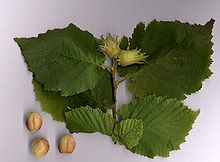Betulaceae
This article includes a list of generalreferences,butit lacks sufficient correspondinginline citations.(March 2013) |
| Betulaceae Temporal range:
| |
|---|---|

| |
| Black alder (Alnus glutinosa) | |
| Scientific classification | |
| Kingdom: | Plantae |
| Clade: | Tracheophytes |
| Clade: | Angiosperms |
| Clade: | Eudicots |
| Clade: | Rosids |
| Order: | Fagales |
| Family: | Betulaceae Gray[1] |
| Type genus | |
| Betula | |
| Subfamilies and genera | |
|
See text | |

| |
| The range of the Betulaceae | |

Betulaceae,thebirch family,includes six genera ofdeciduousnut-bearingtreesandshrubs,including thebirches,alders,hazels,hornbeams,hazel-hornbeam,andhop-hornbeamsnumbering a total of 167 species.[2]They are mostly natives of the temperateNorthern Hemisphere,with a few species reaching theSouthern Hemispherein theAndesinSouth America.Their typical flowers arecatkinsand often appear before leaves.
In the past, the family was often divided into two families, Betulaceae (Alnus,Betula) and Corylaceae (the rest). Recent treatments, including theAngiosperm Phylogeny Group,have described these two groups as subfamilies within an expanded Betulaceae:BetuloideaeandCoryloideae.
Betulaceae flowers are monoecious, meaning that they have both male and female flowers on the same tree. Their flowers present as catkins and are small and inconspicuous, often with reduced perianth parts. These flowers have large feathery stamen and produce a high volume of pollen, as they rely on wind pollination. Their leaves are simple, with alternate arrangement and doubly serrate margins.
Evolutionary history
[edit]The Betulaceae are believed to have originated at the end of theCretaceousperiod (about 70 million years ago) incentral China.This region at the time would have had aMediterranean climatedue to the proximity of theTethys Sea,which covered parts of present-dayTibetandXin gian ginto the earlyTertiaryperiod. This point of origin is supported by the fact that all six genera and 52 species are native to this region, many of those beingendemic.All six modern genera are believed to have diverged fully by theOligocene,with all genera in the family (with the exception ofOstryopsis) having afossil recordstretching back at least 20 million years from the present.
According tomolecular phylogeny,the closest relatives of the Betulaceae are theCasuarinaceae,or the she-oaks.[3]
Uses
[edit]
The common hazel (Corylus avellana) and the filbert (Corylus maxima) are importantorchardplants, grown for their ediblenuts.
The other genera include a number of popularornamental trees,widely planted in parks and large gardens; several of the birches are particularly valued for their smooth, brightly colouredbark.
Thewoodis generally hard, tough and heavy,hornbeamsparticularly so; several species were of significant importance in the past where very hard wood capable of withstanding heavy wear was required, such as forcartwheels,water wheels,cog wheels,toolhandles, chopping boards, and wooden pegs. In most of these uses, wood has now been replaced bymetalor other man-made materials.
Subfamilies and genera
[edit]Extant genera
[edit]- Betuloideae
- Coryloideae
- CarpinusL. 1753– hornbeam
- CorylusL. 1753– hazel
- OstryaScop. 1760– hop-hornbeam
- OstryopsisDecne. 1873– hazel-hornbeam
Fossil genera
[edit]- Betuloidea
- †AlnipollenitesR. Potonié, 1931(pollen)
- †AlnoxylonFelix, 1884(wood)
- †AlnuspollenitesRaatz, 1938(pollen)
- †BetulapollenitesR. Potonié, 1937(pollen)
- †BetulaepollenitesR. Potonié, 1934(pollen)
- †ParalnoxylonDoweld, 2021(wood)
- Coryloidea
- †AsterocarpinusManchester & Crane, 1987(fruits)
- †CoryloidesManchester, 1994(fruits)
- †CraneaManchester & Chen, 1998(fruits, flowers, pollen & Leaves)
- †CorylocarpinusStraus, 1969(fruits)
- †CraspedodromophyllumP.R. Crane, 1981(leaves)
- †KardiaspermaManchester, 1994(fruits)
- †PalaeocarpinusP.R. Crane, 1981(fruits)
- †ParacarpinusManchester & P.R. Crane, 1987(leaves)
- Incertae sedis
- †AlniphyllumNathorst, 1886(leaves)
- †AlnitesGöppert, 1837(leaves, flowers, fruits)
- †AlnophyllumStaub, 1884(leaves)
- †BetulitesGöppert, 1837(flowers)
- †BetulacitesAgranovskaja, Botscharnikova, & Martynova, 1960(pollen)
- †BetuliniumUnger, 1842(wood)
- †TrivestibulopollenitesPflug & P.W. Thomson, 1953(pollen)
- †BetuliphyllumDusén in Nordenskjöld, 1899(leaves)
- †BetuloiditesR. Potonié, Thomson, & Thiergart, 1950(pollen)
- †BetuloxylonKaiser, 1880(wood)
- †CarpinicarpusNikitin, 1966(fruits)
- †CarpiniphyllumNathorst ex Krassilov, 1979(leaves)
- †CarpinitesGöppert & Berendt, 1845(flowers)
- †CarpinoxylonVater, 1884(wood)
- †CarpinuspollenitesR. Potonié, Thomson, & Thiergart, 1949(pollen)
- †CastanopsispollenitesThiergart, 1937(pollen)
- †ClethritesBeuth, 1776(wood)
- †CorylipollenitesR. Potonié, 1934(pollen)
- †CorylitesGardner, 1887(leaves)
- †CoryloiditesR. Potonié, Thomson, & Thiergart, 1949(pollen)
- †CorylophyllumJ. Dawson, 1888(leaves)
- †CoryloxylonU. Prakash, Březinová, & Bůžek, 1971(wood)
- †CoryluspollenitesRaatz, 1938(pollen)
- †EucarpinoxylonMuellerStoll & Maedel, 1959(wood)
- †OstryoipollenitesR. Potonié, 1960(pollen)
- †PhegitesC.N. Lange ex J.F. Krüger, 1825(wood)
- †RhizoalnoxylonConwentz, 1880(root)
- †TriporopollenitesPflug & P.W. Thomson, 1953(pollen)
Phylogenetic systematics
[edit]Modernmolecular phylogeneticssuggest the following relationships:[3][4][5]
| |||||||||||||
References
[edit]- ^Angiosperm Phylogeny Group (2009), "An update of the Angiosperm Phylogeny Group classification for the orders and families of flowering plants: APG III",Botanical Journal of the Linnean Society,161(2): 105–121,doi:10.1111/j.1095-8339.2009.00996.x,hdl:10654/18083
- ^Christenhusz, M. J. M. & Byng, J. W. (2016)."The number of known plants species in the world and its annual increase".Phytotaxa.261(3). Magnolia Press: 201–217.doi:10.11646/phytotaxa.261.3.1.
- ^abSoltis DE, Smith SA, Cellinese N, Wurdack KJ, Tank DC, Brockington SF, Refulio-Rodriguez NF, Walker JB, Moore MJ, Carlsward BS, Bell CD, Latvis M, Crawley S, Black C, Diouf D, Xi Z, Rushworth CA, Gitzendanner MA, Sytsma KJ, Qiu YL, Hilu KW, Davis CC, Sanderson MJ, Beaman RS, Olmstead RG, Judd WS, Donoghue MJ, Soltis PS (2011). "Angiosperm phylogeny: 17 genes, 640 taxa".Am J Bot.98(4): 704–730.doi:10.3732/ajb.1000404.hdl:2027.42/142064.PMID21613169.S2CID8204080.
- ^Xiang X-G, Wang W, Li R-Q, Lin L, Liu Y, Zhou Z-K, Li Z-Y, Chen Z-D (2014). "Large-scale phylogenetic analyses reveal fagalean diversification promoted by the interplay of diaspores and environments in the Paleogene".Perspectives in Plant Ecology, Evolution and Systematics.16(3): 101–110.doi:10.1016/j.ppees.2014.03.001.
- ^Chen Z-D, Manchester SR, Sun H-Y (1999)."Phylogeny and evolution of the Betulaceae as inferred from DNA sequences, morphology, and palaeobotany".Am J Bot.86(8): 1168–1181.doi:10.2307/2656981.JSTOR2656981.PMID10449397.
